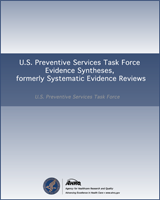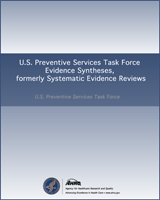NCBI Bookshelf. A service of the National Library of Medicine, National Institutes of Health.
This publication is provided for historical reference only and the information may be out of date.
Structured Abstract
Background:
It is unclear if screening for vitamin D deficiency can improve the health of asymptomatic individuals with this deficiency.
Purpose:
The U.S. Preventive Services Task Force will use this report to develop a recommendation statement on screening for vitamin D deficiency in asymptomatic adults not known to have this deficiency.
Data Sources:
We searched the Cochrane Central Register of Controlled Trials and Cochrane Database of Systematic Reviews (through August 2014) and MEDLINE® (1946 to August 2014), and manually reviewed reference lists from applicable review articles.
Study Selection:
We included systematic reviews; randomized, controlled trials (RCTs); and case-control studies nested within an RCT to examine the benefits of vitamin D treatment (with or without calcium) compared with placebo, calcium alone, or no treatment. We included systematic reviews, RCTs, and cohort or case-control studies to evaluate harms. Included study populations were asymptomatic (i.e., not selected for signs or symptoms of vitamin D deficiency or medical conditions that increase risk for deficiency) adults (age ≥18 years) from the United States, Canada, and Europe with reported serum 25-hydroxyvitamin D [25(OH)D] concentrations of 30 ng/mL or less.
Data Extraction:
No study examined the effect of vitamin D screening on health outcomes. In treatment studies, mortality was decreased in participants randomized to vitamin D treatment (with or without calcium) (11 studies; pooled risk ratio [RR], 0.83 [95% confidence interval (CI), 0.70 to 0.99]). This risk reduction, however, was limited to studies of older institutionalized persons (3 trials; pooled RR, 0.72 [95% CI, 0.56 to 0.94]). Vitamin D treatment was associated with possible decreased risk for falling, including risk for at least one fall (5 studies; RR, 0.84 [95% CI, 0.69 to 1.02]) and number of falls per person (5 studies; incidence rate ratio, 0.66 [95% CI, 0.50 to 0.88]). These findings were not influenced by institutionalized status. Vitamin D treatment (with or without calcium) was not associated with decreased fracture risk (5 studies; pooled RR, 0.98 [95% CI, 0.82 to 1.16]). Neither vitamin D dosage nor baseline level of 25(OH)D in the population influenced risk estimates. Data were limited (≤2 studies) for cancer risk, type 2 diabetes risk, psychosocial functioning, disability, and physical functioning. No trials on the effect of vitamin D treatment on risk for cardiovascular or immune disease met inclusion criteria. Vitamin D treatment (with or without calcium) was not associated with increased risk for harms.
Limitations:
There was no direct evidence on the effect of screening for vitamin D on health outcomes. Evidence on the effects of vitamin D treatment on health outcomes was limited. Most studies that reported harms were not designed to assess harms and lacked rigorous reporting. No study examined effects according to subgroups defined by race, age, and sex. Few studies were conducted in nonwhite, nonfemale populations. There was variability in types of assays used to measure 25(OH)D, baseline 25(OH)D levels of the study population, dosages used, calcium cosupplementation, and duration of followup.
Conclusions:
Treatment with vitamin D, with or without calcium, may be associated with decreased risk for mortality and falls in older or institutionalized adults. Vitamin D treatment did not reduce fracture risk. More research is needed to determine vitamin D treatment's effects in younger noninstitutionalized adults and to clarify the subpopulations that are most likely to benefit from treatment.
Contents
- 1. INTRODUCTION
- 2. METHODS
- 3. RESULTS
- Key Question 1 Is There Direct Evidence That Screening for Vitamin D Deficiency Results in Improved Health Outcomes?
- Key Question 2 What Are the Harms of Screening?
- Key Question 3 Does Treatment of Vitamin D Deficiency With Vitamin D Lead to Improved Health Outcomes?
- Key Question 4 What Are the Adverse Effects of Treatment of Vitamin D Deficiency With Vitamin D?
- 4. DISCUSSION
- REFERENCES
- Appendix A Contextual Questions
- Appendix B Detailed Methods
- Appendix C Evidence and Quality Tables
Acknowledgments: The authors acknowledge Andrew Hamilton, MLS, MS, for conducting literature searches; Rongwei Fu, PhD, for statistical assistance; and Spencer Dandy, BS, for assistance with drafting this report. The authors also thank AHRQ Medical Officers Robert McNellis, MPH, PA, Tina Fan, MD, MPH, and Tess Miller, DrPH, as well as current and former members of the U.S. Preventive Services Task Force who contributed to topic deliberations.
Prepared for: Agency for Healthcare Research and Quality, U.S. Department of Health and Human Services1, Contract No. HHSA-290-2007-10057-I, Task Order No. 13. Prepared by: Pacific Northwest Evidence-based Practice Center2
Suggested citation:
LeBlanc E, Chou R, Zakher B, Daeges M, Pappas M. Screening for Vitamin D Deficiency: Systematic Review for the U.S. Preventive Services Task Force Recommendation. Evidence Synthesis No. 119. AHRQ Publication No. 13-05183-EF-1. Rockville, MD: Agency for Healthcare Research and Quality; 2014.
This report is based on research conducted by the Pacific Northwest Evidence-based Practice Center (EPC) under contract to the Agency for Healthcare Research and Quality (AHRQ), Rockville, MD (Contract No. HHSA-290-2007-10057-I, Task Order Number 13). The findings and conclusions in this document are those of the authors, who are responsible for its contents, and do not necessarily represent the views of AHRQ. No statement in this report should be construed as an official position of AHRQ or of the U.S. Department of Health and Human Services.
The information in this report is intended to help health care decisionmakers—patients and clinicians, health system leaders, and policymakers, among others—make well-informed decisions and thereby improve the quality of health care services. This report is not intended to be a substitute for the application of clinical judgment. Anyone who makes decisions concerning the provision of clinical care should consider this report in the same way as any medical reference and in conjunction with all other pertinent information (i.e., in the context of available resources and circumstances presented by individual patients).
This report may be used, in whole or in part, as the basis for development of clinical practice guidelines and other quality enhancement tools, or as a basis for reimbursement and coverage policies. AHRQ or U.S. Department of Health and Human Services endorsement of such derivative products may not be stated or implied.
None of the investigators have any affiliations or financial involvement that conflicts with the material presented in this report.
- 1
540 Gaither Road, Rockville, MD 20850; www
.ahrq.gov - 2
Oregon Health & Science University, Mail Code: BICC, 3181 SW Sam Jackson Park Road, Portland, OR 97239; www
.ohsu.edu/epc
- Review Interventions to Prevent Falls in Community-Dwelling Older Adults: A Systematic Review for the U.S. Preventive Services Task Force[ 2018]Review Interventions to Prevent Falls in Community-Dwelling Older Adults: A Systematic Review for the U.S. Preventive Services Task ForceGuirguis-Blake JM, Michael YL, Perdue LA, Coppola EL, Beil TL, Thompson JH. 2018 Apr
- Review Aspirin Use in Adults: Cancer, All-Cause Mortality, and Harms: A Systematic Evidence Review for the U.S. Preventive Services Task Force[ 2015]Review Aspirin Use in Adults: Cancer, All-Cause Mortality, and Harms: A Systematic Evidence Review for the U.S. Preventive Services Task ForceWhitlock EP, Williams SB, Burda BU, Feightner A, Beil T. 2015 Sep
- Review Lipid Screening in Childhood and Adolescence for Detection of Familial Hypercholesterolemia: A Systematic Evidence Review for the U.S. Preventive Services Task Force[ 2016]Review Lipid Screening in Childhood and Adolescence for Detection of Familial Hypercholesterolemia: A Systematic Evidence Review for the U.S. Preventive Services Task ForceLozano P, Henrikson NB, Dunn J, Morrison CC, Nguyen M, Blasi PR, Anderson ML, Whitlock E. 2016 Aug
- Review Vitamin D, Calcium, or Combined Supplementation for the Primary Prevention of Fractures in Community-Dwelling Adults: An Evidence Review for the U.S. Preventive Services Task Force[ 2018]Review Vitamin D, Calcium, or Combined Supplementation for the Primary Prevention of Fractures in Community-Dwelling Adults: An Evidence Review for the U.S. Preventive Services Task ForceKahwati LC, Weber RP, Pan H, Gourlay M, LeBlanc E, Coker-Schwimmer M, Viswanathan M. 2018 Apr
- Review Lipid Screening in Childhood for Detection of Multifactorial Dyslipidemia: A Systematic Evidence Review for the U.S. Preventive Services Task Force[ 2016]Review Lipid Screening in Childhood for Detection of Multifactorial Dyslipidemia: A Systematic Evidence Review for the U.S. Preventive Services Task ForceLozano P, Henrikson NB, Morrison CC, Dunn J, Nguyen M, Blasi P, Whitlock EP. 2016 Aug
- Screening for Vitamin D DeficiencyScreening for Vitamin D Deficiency
Your browsing activity is empty.
Activity recording is turned off.
See more...

